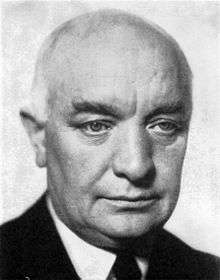Folkhemmet
Folkhemmet (Swedish: [ˈfɔ̂lkˌhɛmːɛt], "the people's home") is a political concept that played an important role in the history of the Swedish Social Democratic Party and the Swedish welfare state. It is also sometimes used to refer to the long period between 1932 and 1976 when the Social Democrats were in power (except for a brief period in 1936 when Axel Pehrsson-Bramstorp from the Farmer's League was prime minister) and the concept was put into practice, but also works as a poetic name for the Swedish welfare state. Sometimes referred to as "the Swedish Middle Way", folkhemmet was viewed as midway between capitalism and socialism. The base of the folkhem vision is that the entire society ought to be like a family, where everybody contributes, but also where everybody looks after one another. The Swedish Social Democrats' successes in the postwar period is often explained by the fact that the party managed to motivate major social reforms with the idea of the folkhem and the national family's joint endeavor.[1][2]
The term is thought to have its roots in Rudolf Kjellén's vision of a corporatist-styled society based on class collaboration in the national interest, largely based on the German Verein für Socialpolitik's juxtaposing of conservative stability and continuity to social reforms otherwise associated with socialist parties, such as universal healthcare and unemployment benefits, as well as ideas from the British Fabian Society and American Progressivism.[3]
The Social Democratic leaders Ernst Wigforss, an avid Keynesian, Gustav Möller and Per Albin Hansson, a social corporatist, are considered the main architects of folkhemmet, with inspiration from the conservative Kjellén and the Danish Social Democrats C.V. Bramsnæs and Karl Kristian Steincke.[4] It was later developed by Prime Ministers Tage Erlander and Olof Palme until the Social Democratic Party lost power in 1976. Another important proponent was Hjalmar Branting, who came into contact with the concept while a student at Uppsala University, and went on to become the first socialist Prime Minister of Sweden.
History
Per Albin Hansson introduced the concept on 18 January 1928,[5] saying that Sweden should become more like a "good home", this being marked by equality and mutual understanding. Hansson advocated that the traditional class society should then be replaced by "the people's home" (folkhemmet).
The concept came at a time when nationalization was being questioned, and marked the party's abandonment of the notion of class struggle, a concept fundamental to the early Social Democratic movement. Instead, they adapted a planned economy under what would later be called funktionssocialism, where businesses were controlled through regulations rather than government ownership. The government would then also have more control over the individual, however, to the extent required to increase the wellbeing of citizens.
Good and easily available education, even to higher levels, was considered particularly important for building the new society. As a result, Sweden became one of the first countries in the world to offer free education at all levels, including all public universities, along with several new universities founded during the 1960s. Free universal health care was provided by the state, enacted in 1947-55, along with numerous other social services.
Myrdal's influence
During the 1930s, social engineering became an important part of folkhemmet. Alva and Gunnar Myrdal's 1934 book Crisis in the Population Question inspired a radical and progressive policy for how to deal with a declining population. A number of changes took place in this period including expansion of the public sector, Wigforss' economic policies, Gustav Möller's reform of the pension system, and Gunnar Myrdal's housing policies.
In the 1940s and 50s, old, worn down houses that served as the overcrowded dwellings of the lower class were demolished. Instead, people were offered modern housing with bathrooms and windows to let light into every room, so called funkis architecture. In the same way, new housing projects – or "working class suburbs" – were constructed in the 1960s and 70s to fulfill the needs of the increasing population in the Miljonprogrammet ("Million Program").
Alva and Gunnar Myrdal suggested a series of programs designed to help families.
In popular culture
- In 1983, Magnus Uggla recorded the album Välkommen till folkhemmet.[6]
See also
References
- Norbert Götz. “The Modern Home Sweet Home.” The Swedish Success Story? Kurt Almqvist and Kay Glans (eds). Stockholm: Axel and Margaret Ax:son Johnson Foundation, 2004. 97–107, 300–302.
- Norbert Götz. Ungleiche Geschwister: Die Konstruktion von nationalsozialistischer Volksgemeinschaft und schwedischem Volksheim. Baden-Baden: Nomos, 2001.
- Sten O. Karlsson: Det intelligenta samhället, Carlsson Bokförlag (20019
- Välfärdsstaten och dess styrningsmekanismer, 1977, in Per Nyström: I folkets tjänst, Ordfront 1983.
- Olle Lönnaeus (21 September 2009). "I valkampen blir alla folkhemskramare" (in Swedish). Sydsvenskan. Retrieved 1 August 2015.
- "Välkommen till folkhemmet" (in Swedish). Svensk mediedatabas. 1983. Retrieved 24 August 2011.
- Bedürftig, Friedemann (2008). Tredje riket från uppgång till fall: en uppslagsbok. Stockholm: Ersatz. Sid. 125–126. ISBN 978-91-88858-32-0
- Götz. Ungleiche Geschwister: Die Konstruktion von nationalsozialistischer Volksgemeinschaft und schwedischem Volksheim

